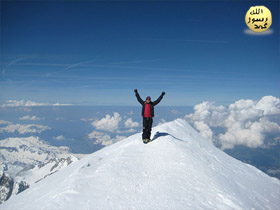
Human beings need oxygen and air pressure in order to live. Breathing is made possible by the oxygen in the atmosphere reaching the air sacs in our lungs. As elevation rises, however, atmospheric pressure goes down as the atmosphere becomes thinner. Therefore, the amount of oxygen entering the blood stream declines and it becomes harder to breathe. As the air sacs grow narrow and contract, we feel as if we cannot breathe.
If the amount of oxygen in the blood is less than the body needs, several symptoms emerge: extreme fatigue, headaches, dizziness, nausea, and loss of judgement. When a certain height is reached, it finally becomes impossible for a human being to breathe at all.173 This is why we need oxygen bottles and special clothing in order to survive at such elevations.
Someone at 5,000-7,500 metres (16,500-24,500 feet) above sea-level may faint and go into a coma because of breathing difficulties. That explains the presence of oxygen equipment in airplanes. There are also special systems that regulate air pressure when planes fly at 9,000-10,000 metres (29,500-33,000 feet) above sea-level.
Anoxia occurs when oxygen fails to reach the tissues. This oxygen deficiency occurs at heights of 3,000-4,500 metres (10,000-15,000 feet). Some people even lose consciousness at such elevations, but can be saved by immediate oxygen treatment.
In the comparison made in the verse below, this physical truth, the changes that take place in the chest with increasing height, is indicated in these terms:
When Allah desires to guide someone, He expands his breast to Islam. When He desires to misguide someone, He makes his breast narrow and constricted as if he were climbing up into the sky. That is how Allah defiles those who have no faith. (Qur'an, 6:125)
173. Medical Encyclopedia, Robert Wood Johnson University Hospital Hamilton, www.rwjhamilton.org/Atoz/Encyclopedia/article/000133.asp.


